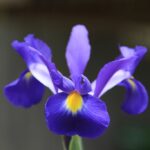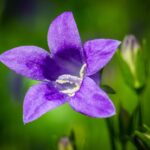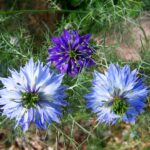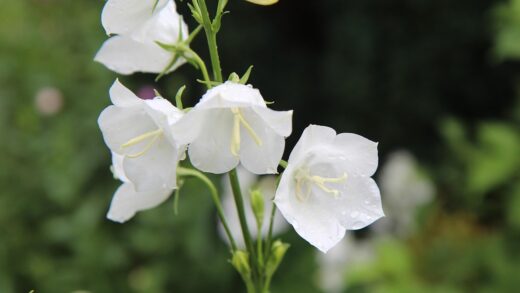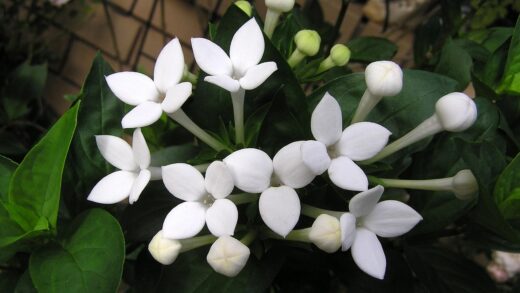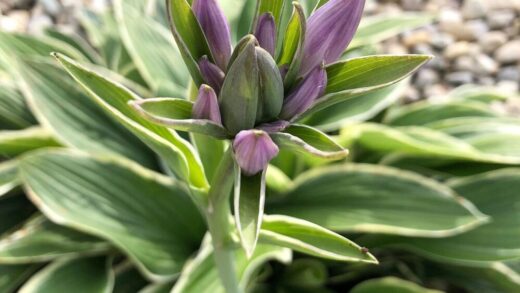The German iris is a resilient perennial that performs best with a lean and balanced diet, making its fertilization a matter of precision rather than abundance. An excess of nutrients, particularly nitrogen, is far more detrimental than a slight deficiency, as it promotes lush, weak foliage at the expense of strong rhizomes and prolific blooms. This soft growth is also significantly more vulnerable to common iris ailments like bacterial soft rot and infestations by the iris borer. Therefore, the primary goal of any fertilization program should be to support the plant’s overall health and flowering capacity by providing key nutrients in the correct proportions and at the appropriate times in its growth cycle.
A soil of average fertility is often sufficient to grow beautiful irises without any supplemental feeding at all. Before embarking on a fertilization routine, it is wise to assess the existing soil quality. A simple soil test can provide invaluable information about the nutrient content and pH, allowing for a targeted approach to amendments. Irises thrive in a soil pH that is neutral to slightly acidic, typically between 6.5 and 7.5. If the soil pH is outside this range, the plant’s ability to absorb available nutrients will be compromised, making fertilization less effective until the pH is corrected.
When fertilization is deemed necessary, the focus should be on providing a balanced source of the three primary macronutrients: nitrogen (N), phosphorus (P), and potassium (K). For German irises, the ideal fertilizer is one that is low in nitrogen but contains adequate amounts of phosphorus and potassium. Phosphorus is vital for stimulating robust root development and is directly linked to the production of flowers. Potassium plays a crucial role in the plant’s overall metabolic processes, improving its vigor, disease resistance, and ability to withstand environmental stresses like drought and cold.
The timing of fertilizer application is as important as the choice of product. Nutrients should be made available to the plant just before and during its periods of active growth. A light application in early spring as new shoots emerge can provide a gentle boost for the developing foliage and flower stalks. A second, equally light application after the blooming period has finished can help to nourish the newly forming rhizomes that will be responsible for the following year’s display. Fertilizing late in the season should be strictly avoided, as it can encourage tender new growth that is easily damaged by winter frosts.
Understanding the nutritional profile of irises
German irises have evolved to thrive in conditions that are not overly rich, and their nutritional needs reflect this adaptation. Their primary storage organs, the rhizomes, allow them to sequester nutrients and energy, making them less dependent on a constant supply from the soil compared to many other garden perennials. This means that a minimalist approach to fertilization is often the most successful. The focus should be on ensuring that essential nutrients are present in the soil in a balanced form, rather than attempting to boost growth with heavy applications of fertilizer.
More articles on this topic
The most common nutritional imbalance that negatively affects irises is an excess of nitrogen. While nitrogen is essential for leaf growth, too much of it creates a plant that is structurally weak and metabolically imbalanced. The foliage becomes overly lush, soft, and a darker green color, which might look healthy to the untrained eye but is actually a sign of vulnerability. This type of growth is highly attractive to sap-sucking insects and provides an easy entry point for diseases. Critically, the plant diverts its energy to producing leaves, resulting in fewer, smaller flowers or, in some cases, no flowers at all.
Phosphorus, on the other hand, is a key element for German irises and is often the limiting nutrient for flower production. It plays a central role in energy transfer within the plant and is fundamental for the development of strong roots and abundant blooms. Soils that are deficient in phosphorus will often produce irises with healthy-looking foliage but very few flowers. This is why fertilizers recommended for irises, such as bone meal or superphosphate, are traditionally high in this element.
Potassium contributes to the overall hardiness and resilience of the plant. It is involved in regulating water movement within the plant’s cells and is essential for activating many of the enzymes responsible for building strong cell walls and synthesizing sugars. A plant with adequate potassium is better able to withstand stresses such as drought, heat, and cold, and it has a greater natural resistance to fungal and bacterial diseases. Therefore, a balanced approach ensures that while nitrogen is kept in check, both phosphorus and potassium are available to support flowering and plant fortitude.
The role of key macronutrients
Nitrogen (N) is often referred to as the “growth” nutrient, as it is a primary component of chlorophyll and amino acids, which are the building blocks of plant proteins. In the context of German irises, a small amount of nitrogen is necessary in the early spring to support the initial development of the characteristic sword-like leaves. However, its application must be carefully managed. Excessive nitrogen leads to the aforementioned problems of weak foliage, reduced flowering, and increased susceptibility to disease. When choosing a fertilizer, the first number in the N-P-K ratio should always be the lowest of the three, or at least equal to the others.
More articles on this topic
Phosphorus (P) is fundamentally the “flower and root” nutrient. Its most critical role in irises is to promote the development of a vigorous root system and to initiate the formation of flower buds within the rhizome. A healthy supply of phosphorus ensures that the plant can efficiently convert solar energy into the chemical energy needed for reproduction. For this reason, many successful iris growers amend their soil with a source of phosphorus before planting. Applying a phosphorus-rich fertilizer after the bloom period can also be beneficial, as this is when the plant is forming the buds for the following year.
Potassium (K) is the “health and vigor” nutrient, contributing to the overall robustness of the plant. It strengthens plant tissues, making them more resilient to physical damage and pathogen attack. Potassium also plays a vital role in osmoregulation, which is the plant’s ability to manage its internal water balance, making it more tolerant of drought conditions. Furthermore, it is essential for the transport of sugars from the leaves, where they are produced during photosynthesis, to the rhizomes, where they are stored as energy reserves. An adequate supply of potassium ensures the plant is well-prepared for winter dormancy and has the energy for strong spring growth.
Beyond these three macronutrients, irises also require a range of micronutrients, such as iron, manganese, and boron, but these are typically needed in very small quantities. In most garden soils with a balanced pH and a decent level of organic matter, these micronutrients are sufficiently available. The use of a good quality compost as a soil amendment is an excellent way to provide a slow-release source of both macronutrients and a full spectrum of essential micronutrients, creating a healthy and sustainable growing environment for the irises.
Choosing the right fertilizer
The ideal fertilizer for German irises is a granular, slow-release product with a low-nitrogen formula. Look for a product with an N-P-K ratio where the first number (nitrogen) is lower than the second two (phosphorus and potassium). Common and effective formulations include 5-10-10, 6-10-10, or even 0-10-10 (which contains no nitrogen). These balanced or “bloom-booster” type fertilizers provide the necessary nutrients for root and flower development without promoting the undesirable flush of weak, leafy growth that high-nitrogen fertilizers would cause.
Traditional amendments are also excellent choices for fertilizing irises. Bone meal is a classic favorite among iris enthusiasts because it is an outstanding organic source of phosphorus and calcium. It breaks down slowly in the soil, providing a steady supply of nutrients over a long period. Superphosphate is a chemical alternative that provides a more readily available source of phosphorus. Both should be incorporated into the soil at planting time or used as a top-dressing in the spring, applied around the base of the plants rather than directly on the rhizomes.
For gardeners who prefer a completely organic approach, well-rotted compost is an invaluable resource. While not a high-potency fertilizer, compost provides a balanced, slow-release source of a wide range of nutrients and micronutrients. More importantly, it dramatically improves soil structure, aeration, and water-retention capabilities, creating a healthier overall growing environment for the irises. A light top-dressing of compost applied around the clumps in the spring is an excellent way to gently feed the plants and nourish the soil simultaneously.
What to avoid is just as important as what to choose. Steer clear of general-purpose lawn fertilizers, as these are typically very high in nitrogen and are detrimental to irises. Fresh or uncomposted manure should also be avoided at all costs. Not only is it excessively high in nitrogen, but it can also harbor harmful pathogens that can contribute to rhizome rot. If using manure, it must be thoroughly composted for at least a year until it is dark, crumbly, and has no strong odor.
Application timing and methods
The timing of fertilizer application for German irises should be synchronized with their active growth phases to ensure maximum uptake and benefit. The first application is best made in early spring, just as the new leaf fans are beginning to show significant growth, typically around 10-15 centimeters in height. This provides the plant with the necessary resources to support the rapid development of its foliage and the impending flower stalks. A light hand is crucial; a small handful of granular fertilizer scattered around the perimeter of each clump is sufficient.
A second application can be beneficial about one month after the flowering period has concluded. This feeding is not for the current season’s growth but is an investment in the following year’s display. During this post-bloom period, the iris is actively developing new rhizomes and setting the flower buds for the next spring. Providing a low-nitrogen, high-phosphorus fertilizer at this time gives the plant the specific nutrients it needs to maximize its reproductive potential and build up energy reserves in the rhizomes before entering summer dormancy.
The method of application is critical to prevent damage to the plant. Granular fertilizers should never be piled directly against the base of the leaf fans or placed on top of the exposed rhizomes. The concentrated salts in the fertilizer can cause chemical burns, creating wounds that can become entry points for rot and disease. The correct method is to sprinkle the fertilizer on the soil surface in a ring around the plant, starting a few centimeters away from the rhizome and extending out to the drip line of the foliage.
After the granular fertilizer has been applied, it should be gently worked into the top centimeter or two of soil with a cultivator or by hand. This helps to bring the granules into contact with soil moisture, which is necessary for them to begin breaking down and releasing their nutrients. Following this, the area should be watered thoroughly. Watering in the fertilizer serves two purposes: it helps to dissolve the nutrients and carry them down into the root zone where they can be absorbed, and it washes off any dust or stray granules that may have landed on the plant tissue.







